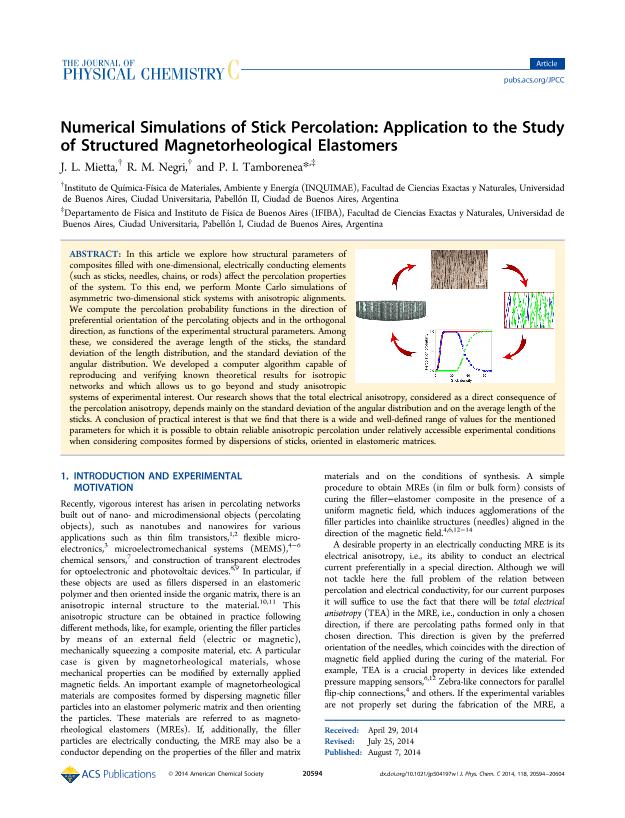Mostrar el registro sencillo del ítem
dc.contributor.author
Mietta, J. L.
dc.contributor.author
Negri, Ricardo Martin

dc.contributor.author
Tamborenea, Pablo Ignacio

dc.date.available
2017-06-12T21:55:07Z
dc.date.issued
2014-08
dc.identifier.citation
Mietta, J. L.; Negri, Ricardo Martin; Tamborenea, Pablo Ignacio; Numerical Simulations of Stick Percolation: Application to the Study of Structured Magnetorheological Elastomers; American Chemical Society; Journal Of Physical Chemistry C; 118; 35; 8-2014; 20594-20604
dc.identifier.issn
1932-7447
dc.identifier.uri
http://hdl.handle.net/11336/18073
dc.description.abstract
In this article we explore how structural parameters of composites filled with one-dimensional, electrically conducting elements (such as sticks, needles, chains, or rods) affect the percolation properties of the system. To this end, we perform Monte Carlo simulations of asymmetric two-dimensional stick systems with anisotropic alignments. We compute the percolation probability functions in the direction of preferential orientation of the percolating objects and in the orthogonal direction, as functions of the experimental structural parameters. Among these, we considered the average length of the sticks, the standard deviation of the length distribution, and the standard deviation of the angular distribution. We developed a computer algorithm capable of reproducing and verifying known theoretical results for isotropic networks and which allows us to go beyond and study anisotropic systems of experimental interest. Our research shows that the total electrical anisotropy, considered as a direct consequence of the percolation anisotropy, depends mainly on the standard deviation of the angular distribution and on the average length of the sticks. A conclusion of practical interest is that we find that there is a wide and well-defined range of values for the mentioned parameters for which it is possible to obtain reliable anisotropic percolation under relatively accessible experimental conditions when considering composites formed by dispersions of sticks, oriented in elastomeric matrices.
dc.format
application/pdf
dc.language.iso
eng
dc.publisher
American Chemical Society

dc.rights
info:eu-repo/semantics/openAccess
dc.rights.uri
https://creativecommons.org/licenses/by-nc-sa/2.5/ar/
dc.subject
Magnetorheological Elastomers
dc.subject
Stick Percolation
dc.subject
Numerical Simulations
dc.subject.classification
Física de los Materiales Condensados

dc.subject.classification
Ciencias Físicas

dc.subject.classification
CIENCIAS NATURALES Y EXACTAS

dc.title
Numerical Simulations of Stick Percolation: Application to the Study of Structured Magnetorheological Elastomers
dc.type
info:eu-repo/semantics/article
dc.type
info:ar-repo/semantics/artículo
dc.type
info:eu-repo/semantics/publishedVersion
dc.date.updated
2017-06-12T18:05:13Z
dc.journal.volume
118
dc.journal.number
35
dc.journal.pagination
20594-20604
dc.journal.pais
Estados Unidos

dc.journal.ciudad
Washington DC
dc.description.fil
Fil: Mietta, J. L.. Consejo Nacional de Investigaciones Científicas y Técnicas. Oficina de Coordinación Administrativa Ciudad Universitaria. Instituto de Química, Física de los Materiales, Medioambiente y Energía. Universidad de Buenos Aires. Facultad de Ciencias Exactas y Naturales. Instituto de Química, Física de los Materiales, Medioambiente y Energía; Argentina
dc.description.fil
Fil: Negri, Ricardo Martin. Consejo Nacional de Investigaciones Científicas y Técnicas. Oficina de Coordinación Administrativa Ciudad Universitaria. Instituto de Química, Física de los Materiales, Medioambiente y Energía. Universidad de Buenos Aires. Facultad de Ciencias Exactas y Naturales. Instituto de Química, Física de los Materiales, Medioambiente y Energía; Argentina
dc.description.fil
Fil: Tamborenea, Pablo Ignacio. Consejo Nacional de Investigaciones Científicas y Técnicas. Oficina de Coordinación Administrativa Ciudad Universitaria. Instituto de Física de Buenos Aires. Universidad de Buenos Aires. Facultad de Ciencias Exactas y Naturales. Instituto de Física de Buenos Aires; Argentina
dc.journal.title
Journal Of Physical Chemistry C

dc.relation.alternativeid
info:eu-repo/semantics/altIdentifier/doi/http://dx.doi.org/10.1021/jp504197w
dc.relation.alternativeid
info:eu-repo/semantics/altIdentifier/url/http://pubs.acs.org/doi/abs/10.1021/jp504197w
dc.relation.alternativeid
info:eu-repo/semantics/altIdentifier/url/https://arxiv.org/abs/1405.0634
Archivos asociados
